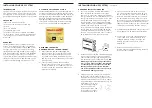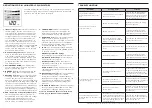
Replacement of batteries located in an
OPERATOR ACCESS AREA
1. When replacing batteries, replace with the
same number of the following battery:
CyberPower / RB1270X2C for the BL1450U.
2.
CAUTION!
Risk of Energy Hazard, 24 V,
maximum 9 Ampere-hour battery. Before
replacing batteries, remove conductive
jewelry such as chains, wrist watches, and
rings. High energy conducted through these
materials could cause severe burns.
3.
CAUTION!
Do not dispose of batteries in a
fire. The batteries may explode.
4.
CAUTION!
Do not open or mutilate batter-
ies. Released material is harmful to the skin
and eyes. It may be toxic.
5.
CAUTION!
A battery can present a risk of
electrical shock and high short circuit cur-
rent. The following precautions should be
observed when working on batteries:
1) Remove watches rings, or other metal
objects.
2) Use tools with insulated handles.
CAUTION - RISK OF EXPLOSION IF BATTERY
IS REPLACED BY AN INCORRECT TYPE.
DISPOSE OF USED BATTERIES ACCORDING
TO LOCAL REGULATIONS.
REMINDER:
Batteries are considered
HAZARDOUS WASTE and must be disposed
of properly. Most retailers that sell lead acid
batteries collect used batteries for recycling, as
required by local regulations.
BATTERY REPLACEMENT PROCEDURE
1. Turn off and unplug all connected
equipment.
2. Turn the UPS off and unplug it from the AC
power source.
3. Turn the UPS on its side on a solid surface
4. Remove two retaining screws located on the
bottom of the UPS.
5. Press on the locking latch and slide the
battery compartment cover.
6. Disconnect the battery wires from the right
side of the battery and then take it out of
the battery compartment.
7. Disconnect the battery wires from the
remaining battery.
8. Slide the remaining battery from left to right
and remove it from the compartment.
9. Install the “left side” replacement battery
by connecting the yellow wire (+) to the red
connector from the battery and the black
wire (-) to the black connector from the
battery. Place the battery into the left side
of the compartment.
10. Install the “right side” replacement battery
by connecting the red wire (+) to the red
connector from the battery and yellow wire
(-) to the black connector from the battery.
Place the battery into the right side of the
compartment. Note: Only new batteries
should be used for replacement and both
batteries should be replaced at the same
time to insure maximum life span.
11. Close the battery compartment cover and
tighten the retaining screws.
12. Recharge the UPS for 8-16 hours to fully
charge the battery.
REPLACING THE BATTERY
Yellow Wire to (+) Red Connector
Black Wire to (-) Black Connector
Red Wire to (+) Red Connector
Yellow Wire to (-) Black Connector
BASIC OPERATION
1. Power Switch
Used as the master on/off switch for equip-
ment connected to the battery power sup-
plied outlets. (Please refer to the Function
Setup Guide for more information.)
2. Power On Indicator
This LED is illuminated when the utility
power is normal and the UPS outlets are
providing power, free of surges and spikes
3. LCD Module Display
The LCD display shows all the UPS informa-
tion using icons and messages. For more in-
formation please review the “Definitions for
Illuminated LCD Indicators” section below.
4. LCD Display Toggle/Selected Switch
The switch can be used to select the LCD
display contents including Input Voltage,
Output Voltage, and Estimated Run Time.
Click the button to scroll down the function
menu. Pressing the button for 3 seconds will
keep the LCD display always on or turn the
LCD display off while in AC/Utility power
mode. For more information, please refer
the Function Setup Guide.
5. USB Charging Ports
The USB Charging ports provide 5V/3A max
(USB-C) and 5V/2.4A max (USB-A) power
output. Total available output current is 4A.
6. Battery and Surge Protected Outlets
The UPS has five battery powered/surge
suppression outlets for connected equip-
ment to ensure temporary uninterrupted
operation of your equipment during a power
failure.
(DO NOT plug a laser printer, paper
shredder, copier, space heater, vacuum,
sump pump or other large electrical devic-
es into the “Battery and Surge Protected
Outlets”. The power demands of these de-
vices may overload and damage the unit.)
7. Full-Time Surge Protection Outlets
The UPS has five surge suppression outlets.
8. Circuit Breaker
Located on the back of the UPS, the circuit
breaker serves to provide overload and fault
protection.
9. USB Port to PC
The USB port allows connection and com-
munication between the USB port on the
computer and the UPS unit.
10. Communication Protection Ports
Communication protection ports, bi-direc-
tional, will protect a 10/100/1000 Ethernet
connection (RJ45).
11. Wiring Fault Indicator (red)
This LED indicator will illuminate to warn
the user that a wiring problem exists, such
as bad ground, missing ground or reversed
wiring. If this is illuminated, disconnect all
electrical equipment from the outlet and
have an electrician verify the outlet is prop-
erly wired. The UPS will not provide surge
protection without being plugged into a
grounded and properly wired wall outlet.
12. Coax/Cable/DSS Surge Protection
The Coax/Cable/DSS protection ports will
protect any cable modem, CATV converter,
or DSS receiver.
13. Widely-Spaced Outlets
The unit has two outlets spaced to allow AC
power adapter blocks to be plugged into
the UPS without blocking adjacent outlets.























